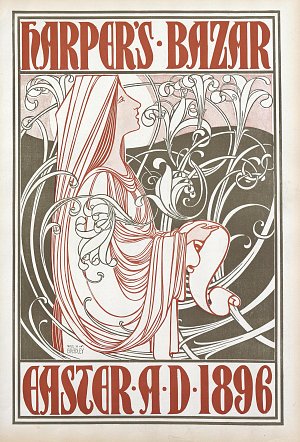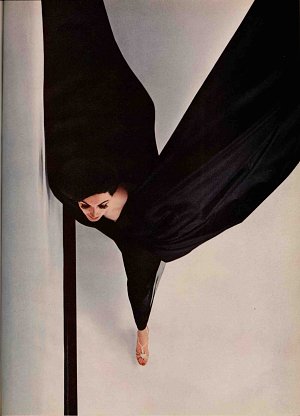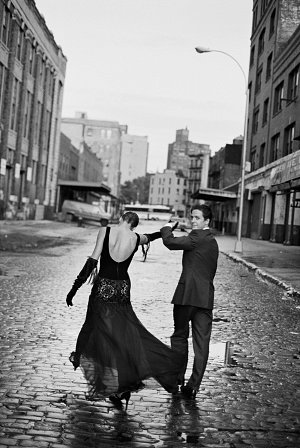
Harper’s Bazaar, March 1896
Drawing by William H. Broadley
© DR
Bazaar was launched in 1867 by Harper & Brothers as a women’s magazine focused on fashion, society, arts, and literature. Styled after European fashion gazettes, it stood out for its commitment to the cause of women. Its first editor, Mary Louise Booth, was a suffragist and an abolitionist who supported the Union during the American Civil War. A woman of letters, Booth was a Francophile who would go on to influence the Bazaar throughout its history. In the 20th century, Picasso, Cocteau, and Matisse were among the many French artists to be featured in the magazine. Bazaar also published articles on the leading figures of the American school, such as Jackson Pollock, Frank Stella, and William Burroughs.
It was also a world-class literary journal, with contributions by Colette, Simone
de Beauvoir, Françoise Sagan, Jean Genet, and André Malraux. Some of the greatest British and American writers, from Charles Dickens to Virginia Woolf, Patricia Highsmith, Truman Capote, and Carson McCullers, wrote for Bazaar.

Balenciaga, Haute couture dress Spring /summer 1955
Paris, Musée des Arts Décoratifs
© MAD, Paris / photo : Jean Tholance
But beyond the quality of its content, it was its aesthetics that set the magazine apart. Its blend of fashion features and perceptive criticism have made Bazaar a touchstone for fashion and graphic design. Great couturiers such as Charles-Frederick Worth, Paul Poiret, Jeanne Lanvin, Madeleine Vionnet, Elsa Schiaparelli, Christian Dior, and Cristóbal Balenciaga owe part of their myth to Bazaar’s prestige.
Staged on two floors of the fashion galleries, the exhibition is arranged chronologically around different themes that have emerged throughout Bazaar’s
history. It aims both to highlight Bazaar’s contribution to the evolution of the female
silhouette over the past 152 years and to show how the magazine’s epochal images
were conceived through the sketches, photographs, and patterns that preceded and inspired them.
Harper’s Bazaar: First in Fashion opens with a short history of fashion periodicals
from the 16th to the 19th century. Mary Louise Booth set the tone for Bazaar by featuring the work of the Parisian couturier Charles-Frederick Worth, a great favorite of American high society. The magazine’s evolution reflected changing styles, from Art Nouveau to the Orientalism of the Ballets Russes and Paul Poiret, which
influenced the covers drawn by Erté in the 1910s and 1920s. It was during this
period that the magazine forged the aesthetics of fashion photography with the work of Baron Adolph de Meyer. In the following years, Surrealism influenced the photographs of George Hoyningen-Huene and George Platt-Lynes, as well as the
cover illustrations created by Cassandre, which echoed the work of Elsa Schiaparelli
and Madeleine Vionnet, who took their inspiration from metaphysics and antiquity.
-

Harper’s Bazaar, June 1964
Photography by Hiro
© DR
-

Gleb Derujinsky, July 1958
© DR
Then there was the “Holy Trinity” that turned Bazaar into an avant-garde
luxury magazine in the 1930s: editor in chief Carmel Snow, art director Alexey Brodovitch, and fashion editor Diana Vreeland. They opened up the magazine
to the great outdoors and to the sunkissed bodies captured in Kodachrome
color by Louise Dahl-Wolfe.
They introduced major photographers like Man Ray, then Richard Avedon, whose
lyrical style chimed with the billowing evening gowns of the postwar years. In
1947, it was Snow who dubbed Christian Dior’s first collection the “New Look,”
ushering in a golden age of couture. By the 1950s, Bazaar had become such a
force in fashion that it was lampooned in the musical Funny Face, starring Audrey
Hepburn. The cultural, social, political, and Pop and Op Art revolutions of the 1960s
were epitomized by Avedon in his famous April 1965 “Now” issue, with model Jean
Shrimpton on the cover.

Hiro, October 1963
© DR
Photographers such as Hiro used fashion as a field of experimentation, employing colored gels and strobes inspired by kinetic art. The images of the 1970s reflected the colorful, vivid fashion of the era. In the 1980s, disco, Dallas, and Dynasty set the tone for the magazine, then headed by Anthony T. Mazzola. During his tenure, close-up portraits of celebrities photographed in Ektachrome started appearing on the covers. In 1992, with Liz Tilberis as editor in chief and Fabien Baron as creative director, the magazine reverted to a more classic
vision of elegance, with a new design and distinctive aesthetic. Photographers such as Patrick Demarchelier and Peter Lindbergh became mainstays, and models like Linda Evangelista and Kate Moss graces the cover.

Peter Lindbergh, November 1992
© Peter Lindbergh (courtesy Peter Lindbergh, Paris)
In 2001, with the arrival of Glenda Bailey as editor in chief, Stephen Gan as creative
director, and later, Elizabeth Hummer as design director, the magazine took a turn for the spectacular and the fanciful, with photographers such as Jean-Paul Goude
as its ringmasters. Bold, ambitious choices marked the period. But the beauty and
vibrancy of the magazine went along with a deep respect for its history.
Harper’s Bazaar: First in Fashion is the first exhibition dedicated to a fashion magazine to look beyond the photographs at the impact of the editorial and artistic direction, the design and the men and women behind it all, as it explores how magazines have helped define what fashion is and what we considerate fashion.